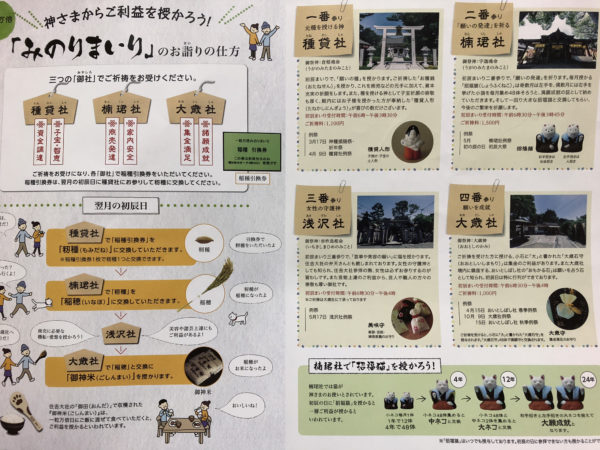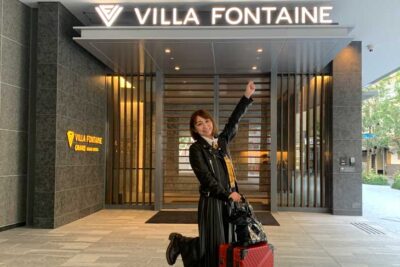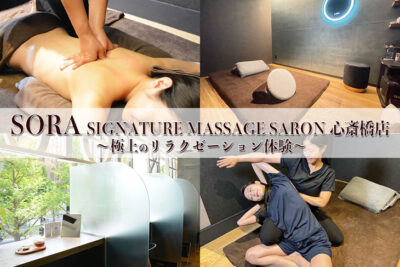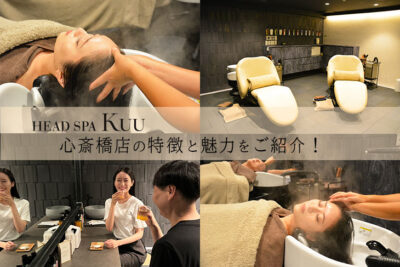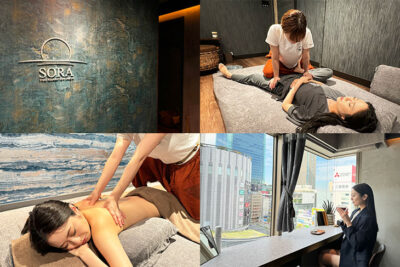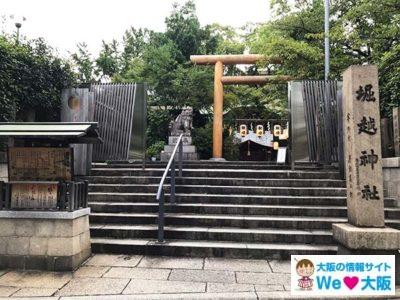- Top
- Destinations
- Visit Sumiyoshi Taisha in Osaka for New Year’s Prayers and Good Fortune
Visit Sumiyoshi Taisha in Osaka for New Year’s Prayers and Good Fortune
2022.09.26
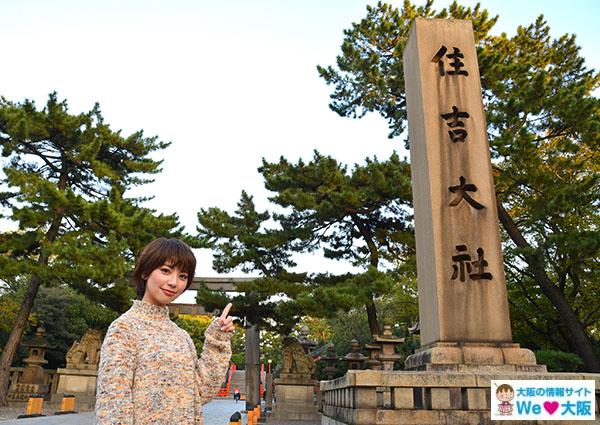
On New Year’s Eve, people across Japan watch their favorite New Year’s specials like Kohaku Uta Gassen or Gaki no Tsukai. And New Year’s Day is a special day because most Japanese will visit their favorite shrine for hatsumode (first shrine visit of the New Year). Many choose Sumiyoshi Taisha Shrine in Sumiyoshi, Osaka. It is said that more than 2 million Hatsumode visitors come to the Sumiyoshi Shrine every year. But while Sumiyoshi Taisha is famous for hatsumode, this is a spot that you can enjoy visiting any time of the year.
For the latest information on the Sumiyoshi Taisha Summer Festival and access by train, please click here.
Sumiyoshi Taisha Summer Festival and Access Info (illustrated)
目次
1. Access
Sumiyoshi Taisha is a 30-minute train ride from Osaka Station via the Osaka Loop Line. Or take the Nankai Line from Namba station. It’s a 9-minute train and takes 3 minutes to walk east.
From Tennoji Station, it takes about 16 minutes by the Hankai Electric Railway streetcar to arrive at Sumiyoshi Torii-mae Station. Or it’s a 5-minute walk west from Sumiyoshi Higashi Station of the Nankai Koya Line.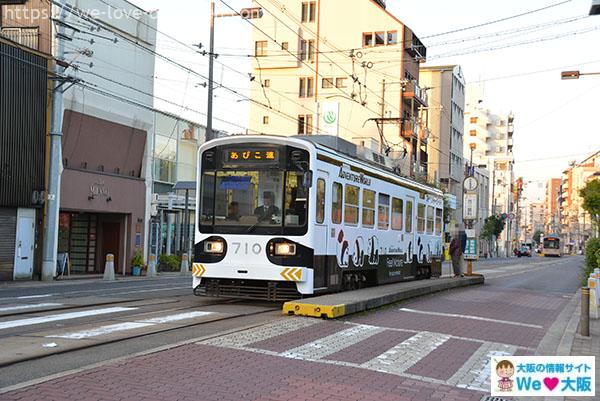 Trams are very rare these days, aren’t they? The stops are more like bus stops than train stations.
Trams are very rare these days, aren’t they? The stops are more like bus stops than train stations.
1-1. From downtown Osaka
■ Osaka Station via JR Loop Line→ Transfer at Shin Imamiya Station to the Nankai Line→Sumiyoshi Taisha Station
■ Namba Station via Nankai Line→Sumiyoshi Taisha Station
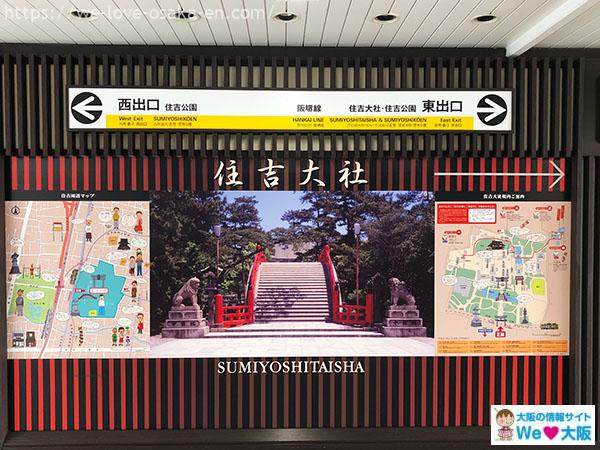
When you exit the ticket gate at Nankai Sumiyoshi Taisha Station, you will see an information board in front of you. To reach Sumiyoshi Taisha Shrine, go down the stairs on the right.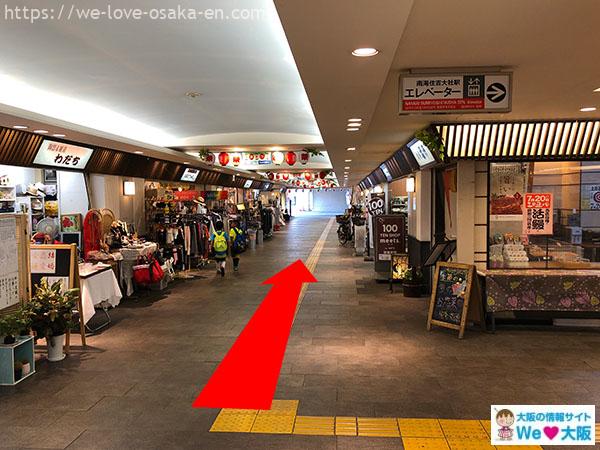 Go down the stairs to the outside where there is a little shopping area.
Go down the stairs to the outside where there is a little shopping area.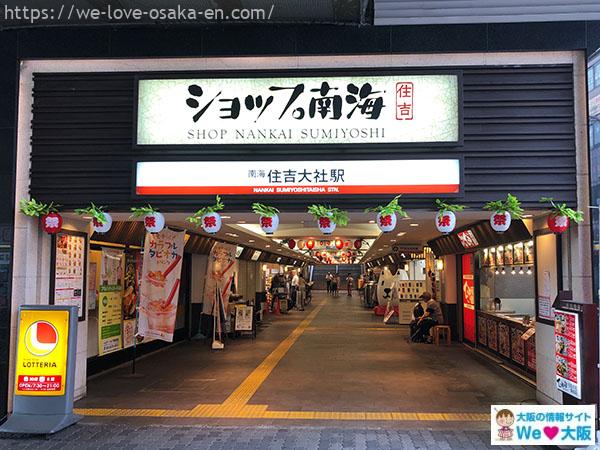 You will come out from here.
You will come out from here.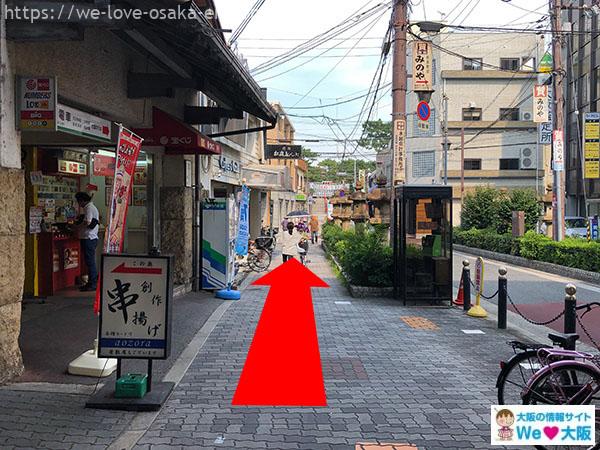 Leave the station and turn left. Go straight and you will find Sumiyoshi Taisha.
Leave the station and turn left. Go straight and you will find Sumiyoshi Taisha.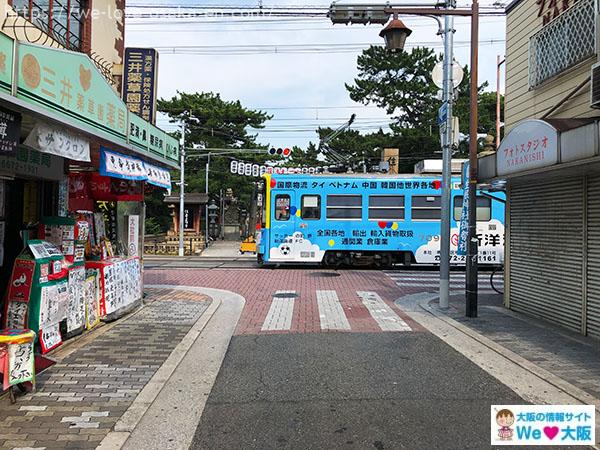 Cross over the Tram Railway.
Cross over the Tram Railway.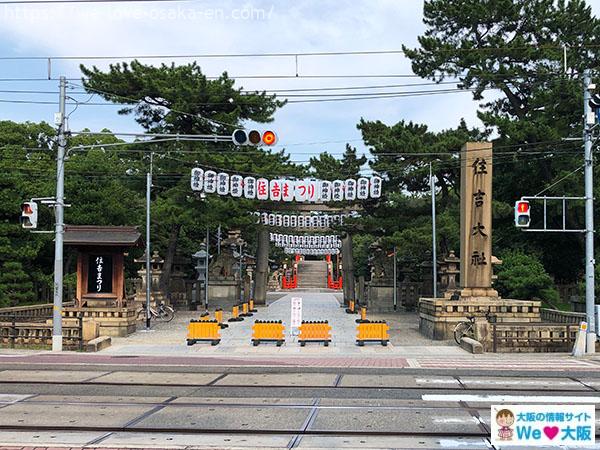 And you can see Sumiyoshi Taisya.
And you can see Sumiyoshi Taisya.
■ Tennoji Ekimae Station via Streetcar Hankai Line→Sumiyoshi Torii-mae Station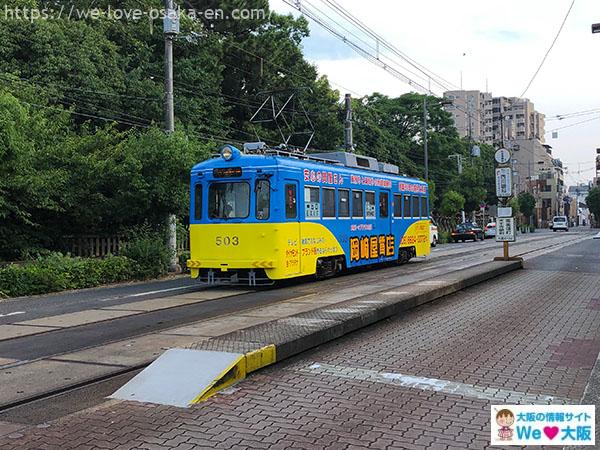 From Tennoji Station, go to Sumiyoshi Taisha on the Hankai Railway Tram. It’s fun to ride the tram, especially if you’re with kids. Sumiyoshi Torii-mae Station is just in front of the shrine’s gate.
From Tennoji Station, go to Sumiyoshi Taisha on the Hankai Railway Tram. It’s fun to ride the tram, especially if you’re with kids. Sumiyoshi Torii-mae Station is just in front of the shrine’s gate.
1-2. From Kansai International Airport
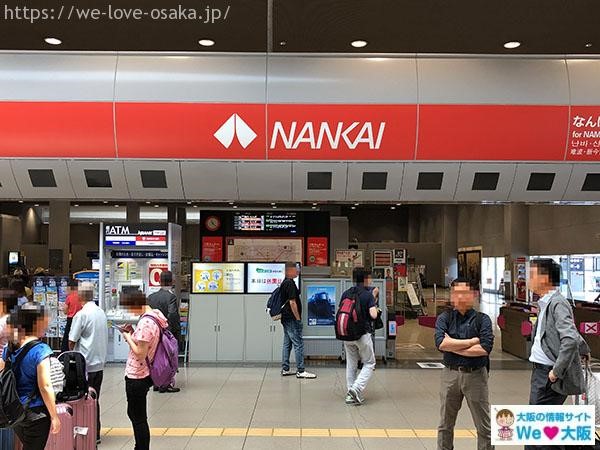 ■Kansai International Airport via Nankai Railway→ Sakai Station→ Sumiyoshi Taisha Station
■Kansai International Airport via Nankai Railway→ Sakai Station→ Sumiyoshi Taisha Station
Take the Nankai Rapito or Airport Express train to Sakai Station, and change to a local train to Sumiyoshi Taisha Station. The walking route is the same as from Osaka City.
Address: 9-89 Sumiyoshi 2-chome Sumiyoshi-ku, Osaka-city 558-0045
TEL: 06-6672-0753
Office hours: 9:00-16:30
Opening time: 6:00 am (April-September); 6:30 am (October – March)
Closing time: Outer gates: 16:00 Inner area: 17:00
Access:
3 minutes on foot from Sumiyoshi Taisha Station of Nankai Line)
5 minutes on foot from Higashi Sumiyoshi Station of Nankai Koya line
In front of Nankai Torii-mae Station of Hankai line
2.What is Sumiyoshi Taisha?
Sumiyoshi Taisha enshrined at Sumiyoshi Grand Shrine is said to be the god of the sea and the god of oharai (purification), and has long been honored as the protector of diplomacy, trade, and industry. He is also mentioned in the Nihon Shoki (Chronicles of Japan) and Kojiki (Records of Ancient Matters). According to these texts, when Izanagi no Mikoto purified himself, three deities were born from the sea: Sokoatsutsuno-no-mikoto, Nakatsutsuno-no-mikoto, and Omototsutsuno-no-mikoto, collectively called Sumiyoshi-no-mikoto.
Empress Jingu, the empress of the 14th Emperor Nakai, enshrined Sumiyoshi at this site in 211 A.D. Later, the empress herself was also enshrined at this site. Later, the Empress herself wanted to live together with Sumiyoshi-taijin, so they were enshrined together, and so now four deities are enshrined at Sumiyoshi Taisha Shrine. There are more than 2,300 Sumiyoshi shrines throughout Japan, and Sumiyoshi Taisha is the head shrine.
3. Sori Bridge
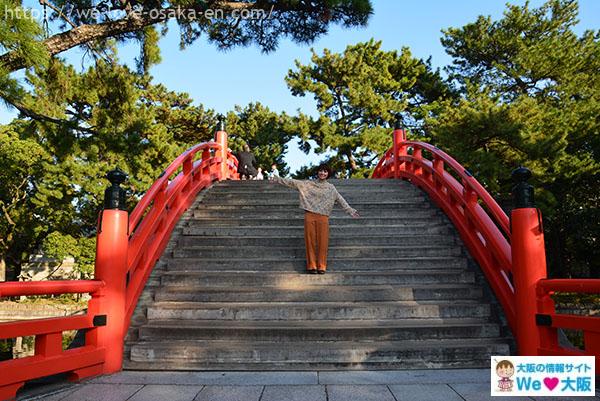 The first thing that you’ll see as you approach Sumiyoshi Taisha is the famous Sorihashi Bridge, which is the most famous bridge in Sumiyoshi Taisha Shrine. From the front, it looks like a steep staircase.
The first thing that you’ll see as you approach Sumiyoshi Taisha is the famous Sorihashi Bridge, which is the most famous bridge in Sumiyoshi Taisha Shrine. From the front, it looks like a steep staircase.
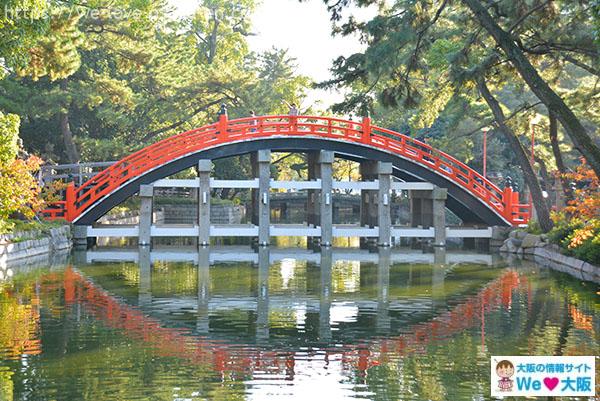 From the side you can see it is a drum bridge! It is also a great photo opportunity. The reflection in the water is beautiful. Crossing this bridge is said to be a way to purify oneself of sins and impurities in order to approach the gods, and was compared to a rainbow as a bridge connecting the earthly realm and the heavenly realm of the gods. It is also known that Yasunari Kawabata wrote in his novel, “It is more difficult to descend from a bridge than to ascend on it.” The steep angle of the descent is truly frightening, so please be careful when descending! Sorihashi is lit up at night until 9:00 p.m. and has been selected as one of the 100 best night views in Kansai.
From the side you can see it is a drum bridge! It is also a great photo opportunity. The reflection in the water is beautiful. Crossing this bridge is said to be a way to purify oneself of sins and impurities in order to approach the gods, and was compared to a rainbow as a bridge connecting the earthly realm and the heavenly realm of the gods. It is also known that Yasunari Kawabata wrote in his novel, “It is more difficult to descend from a bridge than to ascend on it.” The steep angle of the descent is truly frightening, so please be careful when descending! Sorihashi is lit up at night until 9:00 p.m. and has been selected as one of the 100 best night views in Kansai.
4. Kaku Torii Gate
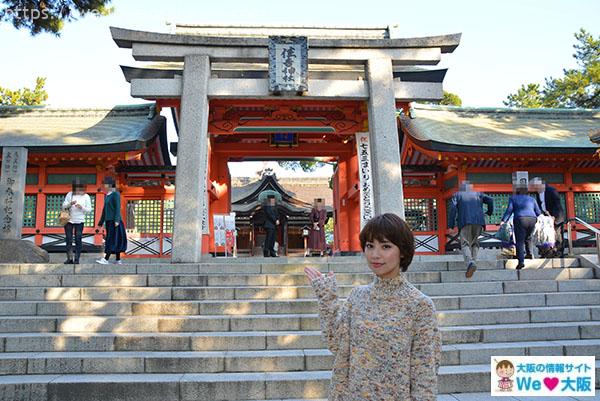 The torii gate of Sumiyoshi Taisha Shrine is a very rare stone-built torii with four square pillars, also called kaku-torii (square torii). The original wooden vermilion-lacquered torii gates were erected between the main shrine building and the hall of worship.
The torii gate of Sumiyoshi Taisha Shrine is a very rare stone-built torii with four square pillars, also called kaku-torii (square torii). The original wooden vermilion-lacquered torii gates were erected between the main shrine building and the hall of worship.
5. The Main Hall
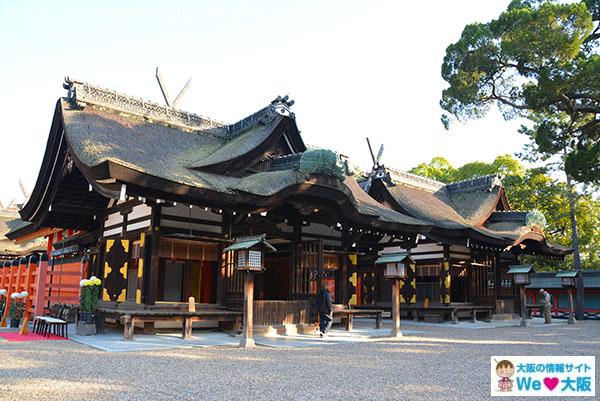 Passing through the torii gate, visitors will see the main shrine. The present main shrine was built in 1810 and is designated as one of Japan’s National Treasures . The four main shrines and their respective deities all face west toward Osaka Bay, with the first through third main shrines in series and the fourth and third shrines in parallel, an architectural arrangement that is rare in Japan. The sight of the buildings standing together like a fleet of ships on the open sea is breathtaking!
Passing through the torii gate, visitors will see the main shrine. The present main shrine was built in 1810 and is designated as one of Japan’s National Treasures . The four main shrines and their respective deities all face west toward Osaka Bay, with the first through third main shrines in series and the fourth and third shrines in parallel, an architectural arrangement that is rare in Japan. The sight of the buildings standing together like a fleet of ships on the open sea is breathtaking!
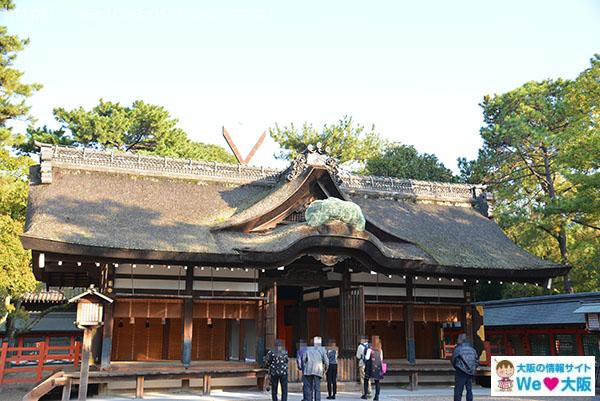 All of the main shrines are said to be built in the Sumiyoshi-zukuri style, with cypress bark roofs and straight gables. The sloping roof on both sides of the ridge looks like an open book. The entrance is called tsumairi, and is characterized by the two ends of the roof facing the front. The Sumiyoshi-zukuri style is said to be one of the oldest in the history of shrine architecture, and the weight of the history that has been handed down seems to envelop visitors with its power.
All of the main shrines are said to be built in the Sumiyoshi-zukuri style, with cypress bark roofs and straight gables. The sloping roof on both sides of the ridge looks like an open book. The entrance is called tsumairi, and is characterized by the two ends of the roof facing the front. The Sumiyoshi-zukuri style is said to be one of the oldest in the history of shrine architecture, and the weight of the history that has been handed down seems to envelop visitors with its power.
6. Ise Shrine worship space
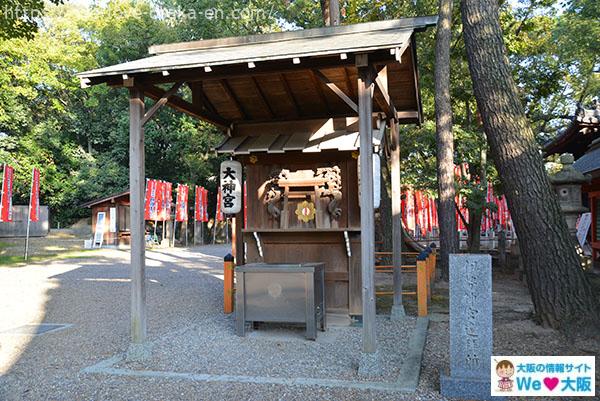 This is another spot you should visit. It is located just past the gate on the left from the first main shrine.
This is another spot you should visit. It is located just past the gate on the left from the first main shrine.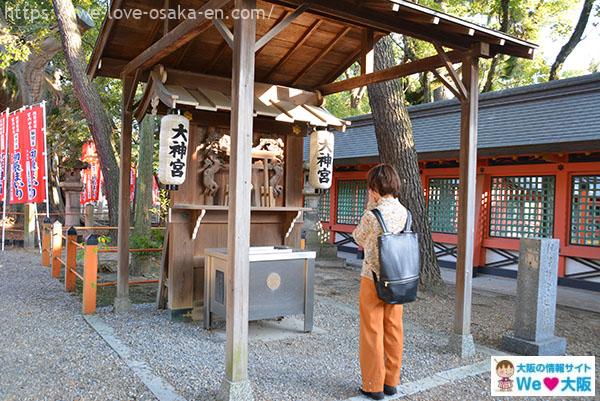 This spot is for worshipping gods, Buddha, etc. far from a distance. This place is for those who want to pray at Ise Jingu Shrine.
This spot is for worshipping gods, Buddha, etc. far from a distance. This place is for those who want to pray at Ise Jingu Shrine.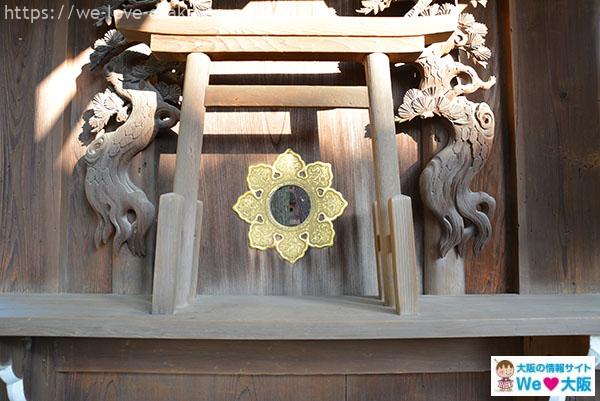 The mirror-like object in the middle is actually a hole through which you can see the back of the building. It almost looks as if it is connected to Ise Jingu Shrine.
The mirror-like object in the middle is actually a hole through which you can see the back of the building. It almost looks as if it is connected to Ise Jingu Shrine.
7. Gosho Gozen
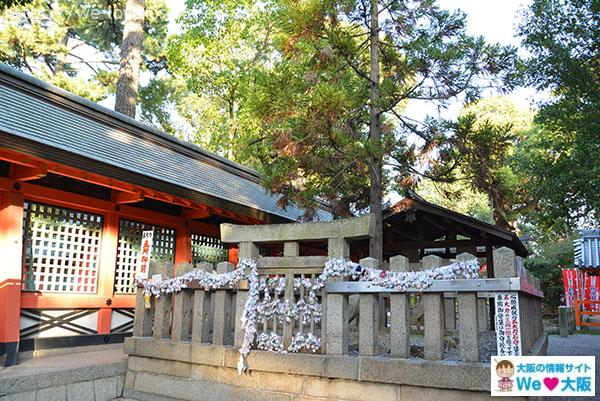 Gosho Gozen is an area with a cedar tree surrounded by a stone ball fence. It is located to the right from the first main shrine. It is said that when Empress Jingu asked for land to worship Sumiyoshi Taishin, three white herons came and perched in this cedar tree, and so the shrine was dedicated here. Every year in May, during the Unoha ritual to commemorate the founding of Sumiyoshi Taisha, a sacred rabbit-leaf skewer is offered.
Gosho Gozen is an area with a cedar tree surrounded by a stone ball fence. It is located to the right from the first main shrine. It is said that when Empress Jingu asked for land to worship Sumiyoshi Taishin, three white herons came and perched in this cedar tree, and so the shrine was dedicated here. Every year in May, during the Unoha ritual to commemorate the founding of Sumiyoshi Taisha, a sacred rabbit-leaf skewer is offered.
7-1. Godai Riki
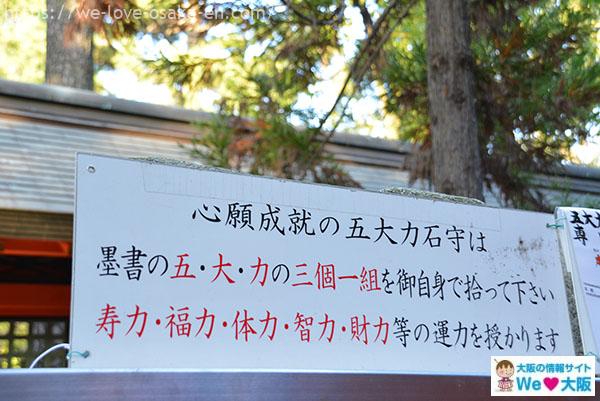
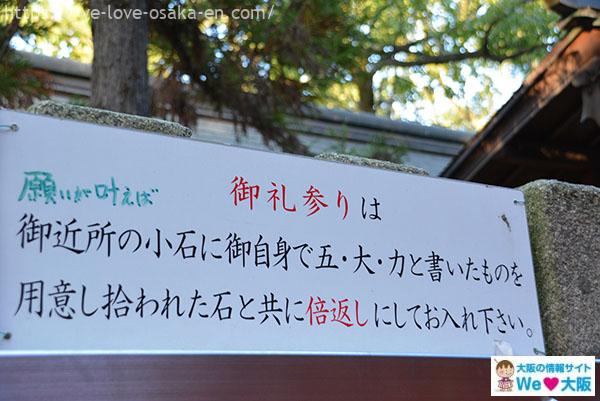 Inside the stone wall are three pebbles with the words “Five, Great, and Power” written on them. If taken as amulets, they are said to bless one and help fulfill one’s wishes. The five powers are longevity, good fortune, physical strength, wisdom, and wealth.
Inside the stone wall are three pebbles with the words “Five, Great, and Power” written on them. If taken as amulets, they are said to bless one and help fulfill one’s wishes. The five powers are longevity, good fortune, physical strength, wisdom, and wealth.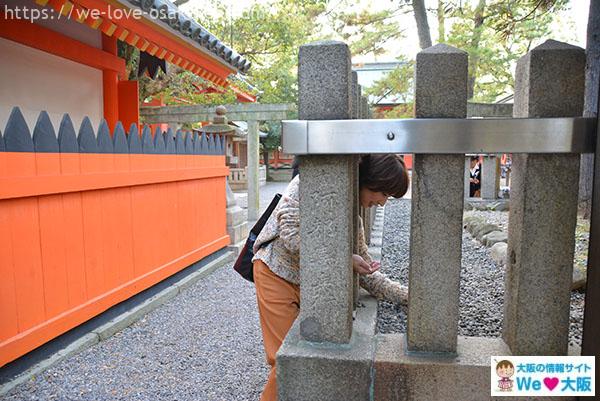 As picture here, thrust your head between the stone’s fence and find your pebble of choice.
As picture here, thrust your head between the stone’s fence and find your pebble of choice.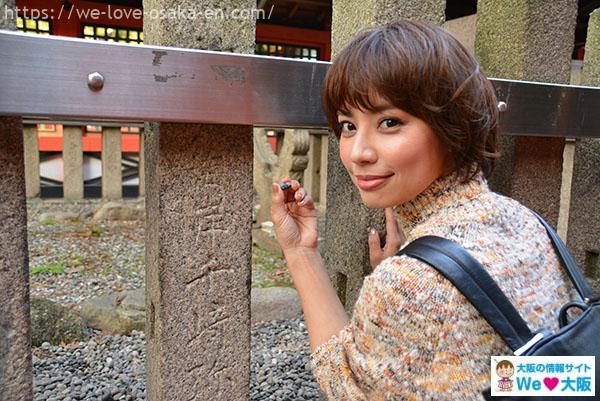
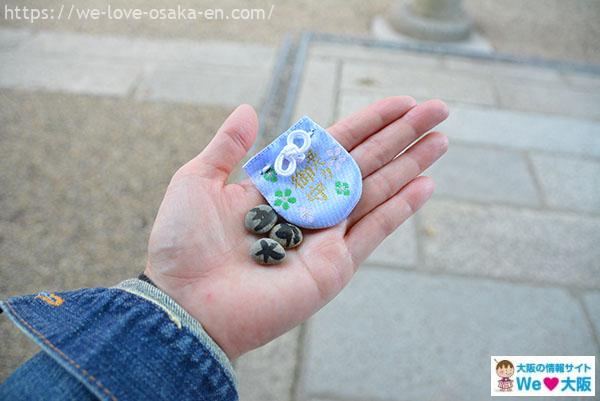
It is said that if you put the three stones in an amulet bag (available at the main shrine awarding office for 300 yen) and leave it in your bag or room, it will bring you good luck. After your wish is granted, write the words “Five,” “Great,” and “Power” on your lucky stones and return them to pass on your good luck to the next person.
Many people were picking up stones when I visited! They are pretty easy to find, so come and gain th good fortune of the Five Great Powers!
8. Typical festivals
8-1. Ota Ue Shinji
Let us introduce some of the common festivals held at Sumiyoshi Taisha Shrine. In June the Otaue Shinji (rice planting ritual) is held. It is designated as an Important Intangible Folk Cultural Asset. The ritual is said to have started when Empress Jingu established a rice field, and is held in the field located south of the shrine grounds. It is believed that powerful grain spirits reside in the seedlings planted in Mother Earth, and the ceremony is still held solemnly to welcome the autumn season so grains grow in abundance and ears of rice are fully harvested.
8-2. Sumiyoshi Festival
Every year when summer arrives, the Sumiyoshi Festival is held from July 30 to August 1.
The Sumiyoshi Taisha Shrine is also known for the god of purification, so it is said that the parade of portable shrines carried by the shrine purifies Osaka City. The portable shrine, with the spirit of Sumiyoshi Taisha within, is paraded in a procession to Shukuin-tongu in Sakai, where the procession is called Mikoshi-togyo. The portable shrine procession was revived in 2005 after a 45-year absence, and is now held with great fanfare as the climax of the festival.
8-3. Hatsutatsu Worship
Hatsutatsu-mairi is held on the first dragon day of each month. It is popularly known as “Hattatsu-san” for business development and family safety. On the first dragon day of each month, many visitors come from far and wide, and the shrine is crowded with worshippers from early in the morning.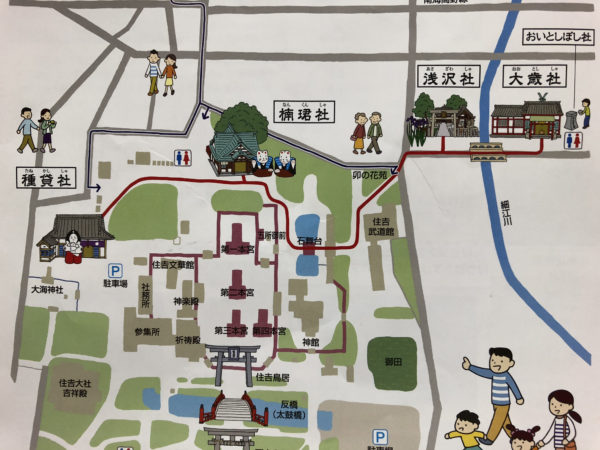 Click the photo to enlarge
Click the photo to enlarge
It is customary to visit four of the year-end shrines related to Sumiyoshi Taisha: Tanekashi-sha, Nankun-sha, Asazawa-sha, and Otoshi-sha. It has been believed that if you visit the shrine on the first dragon day of each month, you will be protected by the shrine deities. If one visits the shrines 48 times in a four-year period, one’s wish will be fulfilled.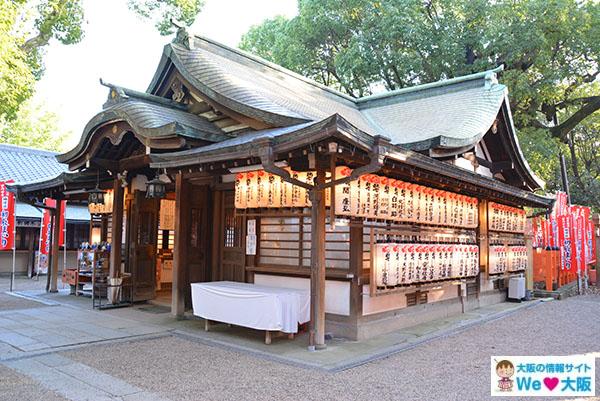 This is the Nankun Shrine. It houses the god for business development and house safety. It is said that if you receive a Shofuku Neko (lucky cat) on the first day of the first dragon, you will receive even more blessings.
This is the Nankun Shrine. It houses the god for business development and house safety. It is said that if you receive a Shofuku Neko (lucky cat) on the first day of the first dragon, you will receive even more blessings.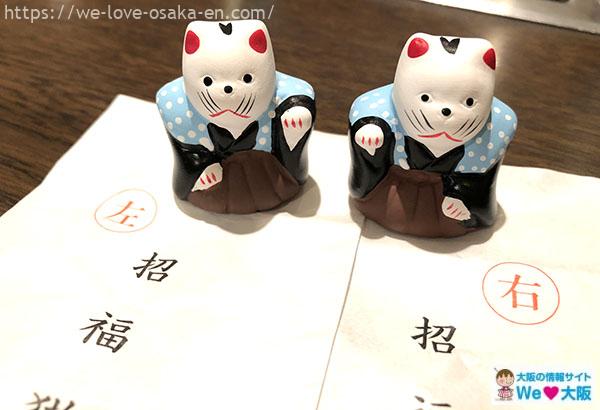 Shoufuku cats can be collected at any time other than the first dragon’s day.
Shoufuku cats can be collected at any time other than the first dragon’s day.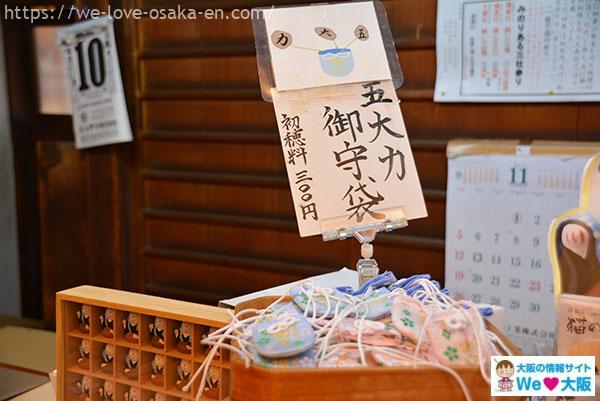 The amulet bag of Godai-ryoku can also be purchased at Nankun Shrine. There are many other shrines within Sumiyoshi Taisha, so you can receive various blessings from them. If you pay careful attention to each of them, you may return home full of various powers bestowed by the gods!
The amulet bag of Godai-ryoku can also be purchased at Nankun Shrine. There are many other shrines within Sumiyoshi Taisha, so you can receive various blessings from them. If you pay careful attention to each of them, you may return home full of various powers bestowed by the gods!
9. Omokaru Stone fortune telling (Oitoshiboshi Shrine)
The “Omokaruseki” stone at Oitoshiboshi Shrine, which sits within the precincts of Otoshi Shrine, is known as a stone for divining one’s wishes.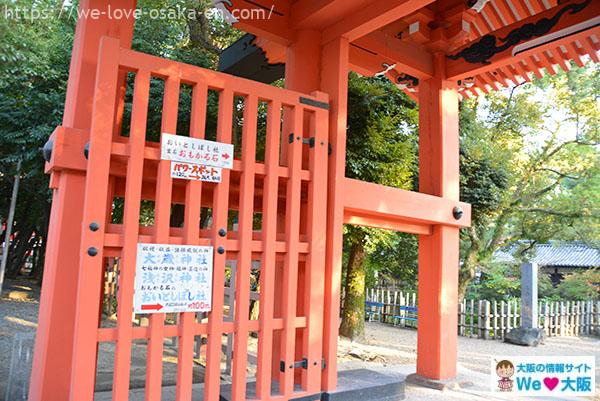 To get there, there is a red gate near Gosho Gozen. There is an Omokaru Stone at the Oitoshiboshi Shrine, which is located outside the Sumiyoshi Taisha Shrine.
To get there, there is a red gate near Gosho Gozen. There is an Omokaru Stone at the Oitoshiboshi Shrine, which is located outside the Sumiyoshi Taisha Shrine.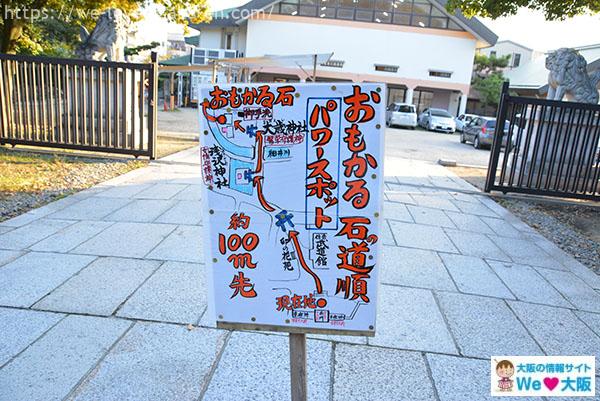 Here is hand-written map with directions to the Omokaru Stone.
Here is hand-written map with directions to the Omokaru Stone.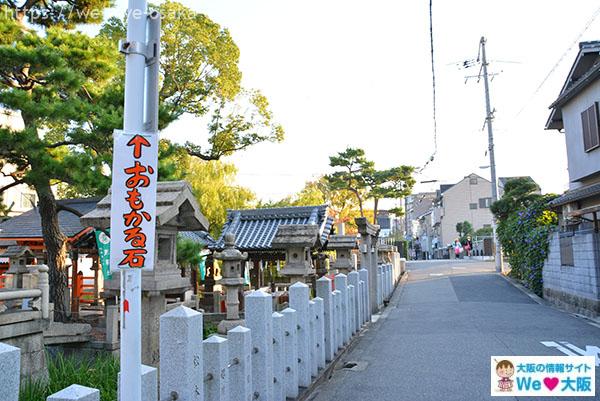 There are also signs along the way so you don’t get lost.
There are also signs along the way so you don’t get lost.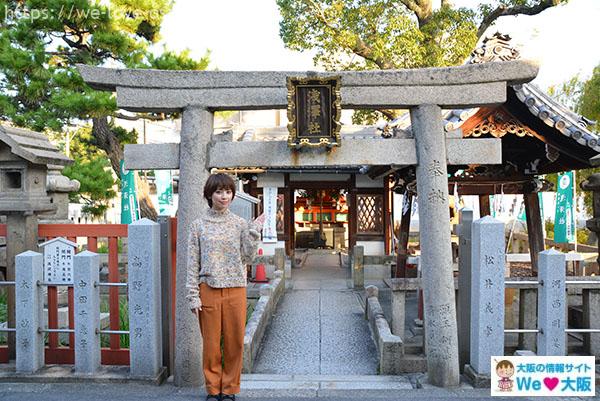 This is Asazawa Shrine. It was also mentioned in the Hatsutatsu-mairi. Asazawa holds a guardian deity for women and a god of beauty, entertainment, tact, and affection. Women should definitely pay a visit to this shrine.
This is Asazawa Shrine. It was also mentioned in the Hatsutatsu-mairi. Asazawa holds a guardian deity for women and a god of beauty, entertainment, tact, and affection. Women should definitely pay a visit to this shrine.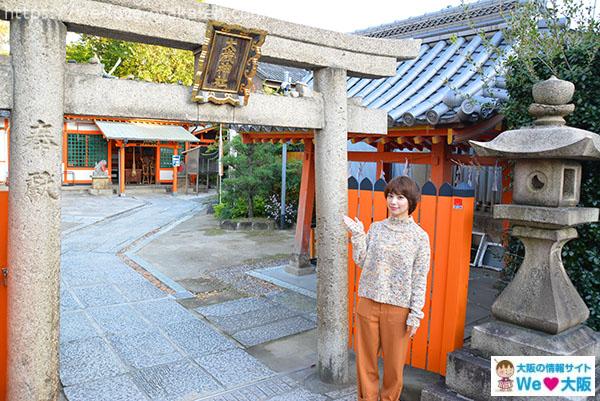 After passing by Asazawa shrine you can find Ootoshi shrine.
After passing by Asazawa shrine you can find Ootoshi shrine.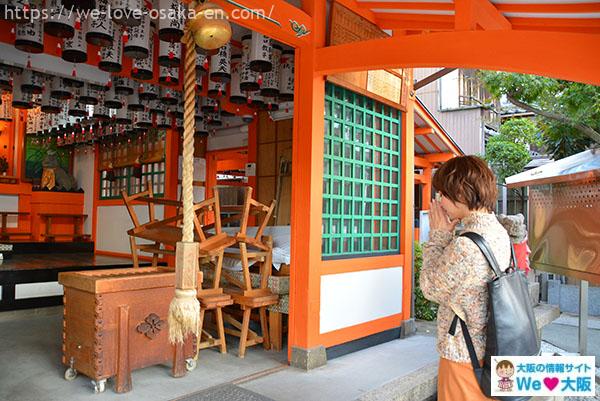 First of all, after visiting Ootoshi shrine,
First of all, after visiting Ootoshi shrine,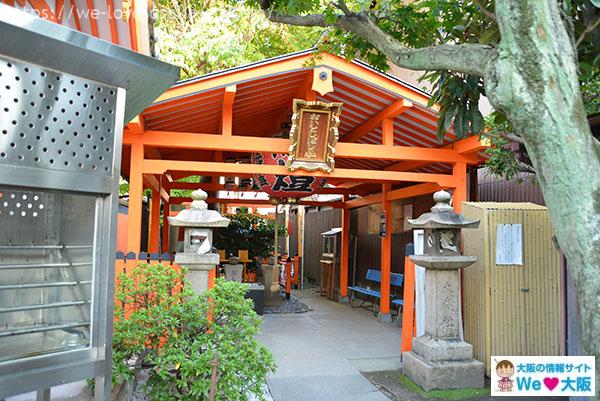 Turning to the right will take you to Oitoshiboshi Shrine.
Turning to the right will take you to Oitoshiboshi Shrine.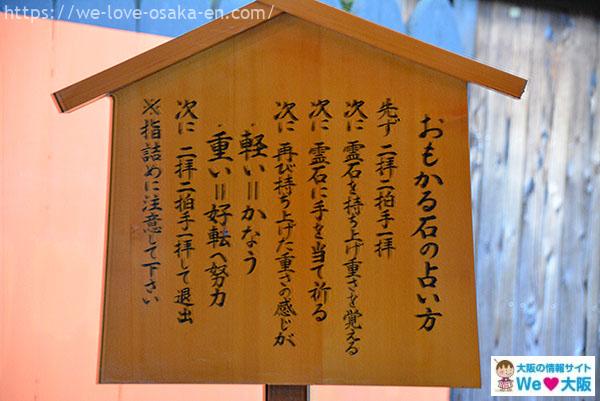 The signboard instructs how to tell your fortune using the Omokaru Stone
The signboard instructs how to tell your fortune using the Omokaru Stone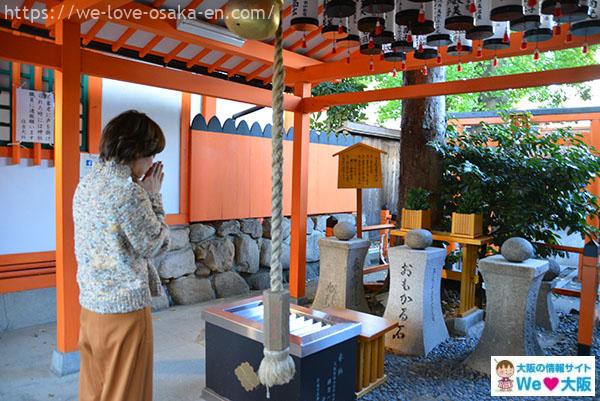 First, two bows, two claps, and one bow.
First, two bows, two claps, and one bow.
Next, lift the sacred stone and feel its weight.
Next, place your hand on the sacred stone and pray.
Next, lift it up again and feel its weight.
If it feels light, your wish will come true. A heavy stone requires effort for a favorable turn of event.
Lastly, bow twice, clap twice, pray, and leave the temple.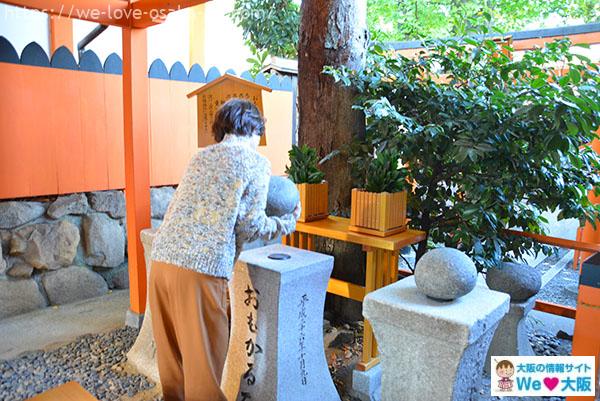 What do you think? You want to try it, won’t you? By the way, I, the photographer of the pictures, feel lighter! (Wishful thinking maybe) And Mana-chan, the model who appears above, said, “It’s so heavy! (Good luck Mana-chan!)
What do you think? You want to try it, won’t you? By the way, I, the photographer of the pictures, feel lighter! (Wishful thinking maybe) And Mana-chan, the model who appears above, said, “It’s so heavy! (Good luck Mana-chan!)
10. Nearby foodie destinations
Before heading home, you may want to stop by the Sumiyoshi Taisha Monzenmachi gourmet spots.
10-1. Western food “Yaroku”
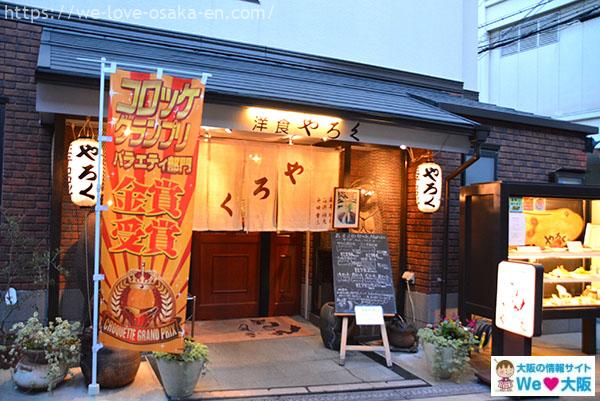 This is Yoshoku Yaroku. It has been in business since 1935 and is a common place for visitors to Sumiyoshi Taisha Shrine to come eat. The egg croquette is especially famous, and the buttery egg cream is truly delicious! The croquettes are so luxurious with plump prawns inside. You will definitely be satisfied with this croquette. Please try it!
This is Yoshoku Yaroku. It has been in business since 1935 and is a common place for visitors to Sumiyoshi Taisha Shrine to come eat. The egg croquette is especially famous, and the buttery egg cream is truly delicious! The croquettes are so luxurious with plump prawns inside. You will definitely be satisfied with this croquette. Please try it!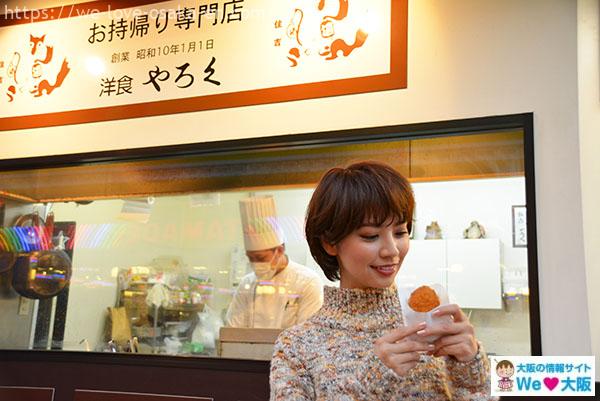 There is also a take-out store near the main store under the Nankai Line. It is recommended for those who want to buy a quick bite and eat freshly fried food.
There is also a take-out store near the main store under the Nankai Line. It is recommended for those who want to buy a quick bite and eat freshly fried food.
Address: 3-30-16 Higashi Kohama Sumiyoshi-ku Osaka-city 558-0051
TEL: 06-6671-5080
Opening hours: 11:00-13:30 and 16:30-20:00 (or until sold out)
Holidays: Wednesday/4th Tuesday of the month (only open for lunch)
10-2.Okonomiyaki Shirakaba
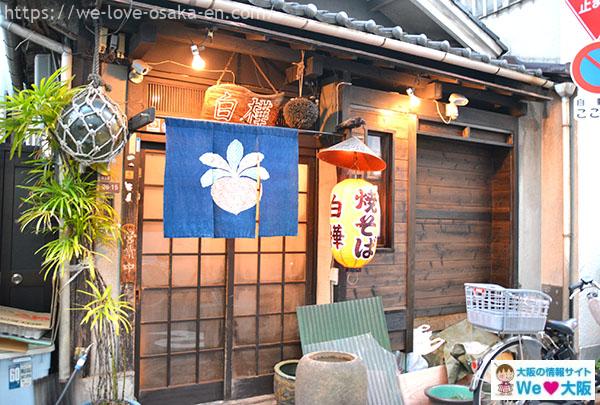 Shirakaba is an okonomiyaki restaurant with a Showa Era vibe. Both the interior and exterior will bring you back in time to the Showa Era. It’s as if time has stood still here. There are only about 10 seats at the counter surrounding the griddle, making it a very cozy place! All you need to ask for is a pork omelet and a beer!
Shirakaba is an okonomiyaki restaurant with a Showa Era vibe. Both the interior and exterior will bring you back in time to the Showa Era. It’s as if time has stood still here. There are only about 10 seats at the counter surrounding the griddle, making it a very cozy place! All you need to ask for is a pork omelet and a beer!
The fluffy dough filled with yams is slowly grilled over low heat and finished with Worcestershire sauce, tonkatsu sauce, mayonnaise, ketchup, and hot pepper. Cut into pieces with a trowel and eat while huffing and puffing, your mouth will be full of happiness. And when you pour down a cold beer in one gulp, you will want to shout, “Oh, my God!” You have to try it!
Address: 3-28-15 Higashi Kohama, Sumiyoshi-ku, Osaka-city 558-0051
TEL: 06-6671-1127
Opening hours: 11:00-14:00 and 16:30-20:00
Closed: Wednesday
10-3. Suehiro Do
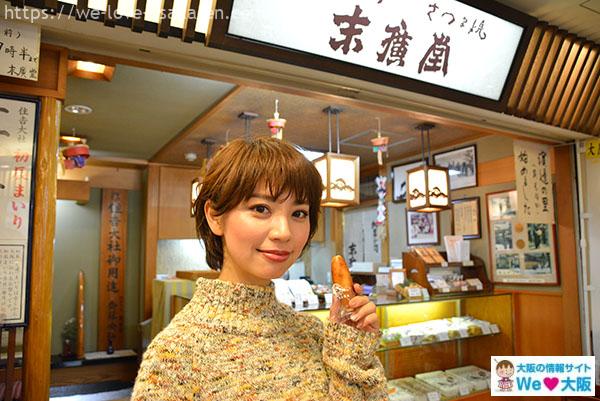 Our last recommendation is Suehirodo’s Satsumayaki. It is said that many people buy this Japanese confectionery when they visit Sumiyoshi Taisha Shrine. It is said that the shop was founded as far back as the Genroku Period (1688-1704). Satsumayaki is a baked sweet made from Tokachi azuki beans and wrapped in a unique skin. It is not too sweet, rather it’s the perfect elegant Japanese confectionery. It is a must-have sweet to take home as a souvenir after visiting the shrine.
Our last recommendation is Suehirodo’s Satsumayaki. It is said that many people buy this Japanese confectionery when they visit Sumiyoshi Taisha Shrine. It is said that the shop was founded as far back as the Genroku Period (1688-1704). Satsumayaki is a baked sweet made from Tokachi azuki beans and wrapped in a unique skin. It is not too sweet, rather it’s the perfect elegant Japanese confectionery. It is a must-have sweet to take home as a souvenir after visiting the shrine.
Address: 3-12-14 Higashi Kohama, Sumiyoshi-ku, Osaka-city 558-0051
TEL: 06-6678-8130
Opening hours: 9:00-19:30
Closed: Open all year round
Summary
What do you think? Would you like to visit Sumiyoshi Taisha Shrine now? It is a good place to visit for New Year’s, but also any other time of the year. Sumiyoshi Taisha Shrine has a number of regent shrines (shrines closely related to Sumiyoshi-taisha Shrine) and suisha (shrines related to Sumiyoshi-taisha Shrine), and there are many places to visit nearby. Whether you want to visit Hatsutatsu-mairi, Ise Jingu Shrine or Godai-ryoku ni Omogaru Ishi, you can definitely enjoy your visit to Sumiyoshi Taisha Shrine.
Related article
-
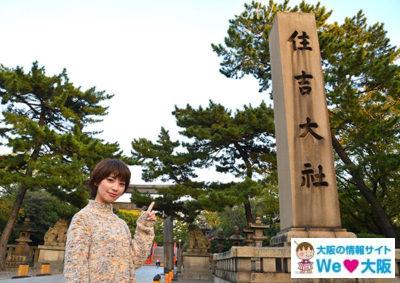
Visit Sumiyoshi Taisha in Osaka for New Year’s Prayers and Good Fortune
On New Year's Eve, people acro……2022.09.26
-
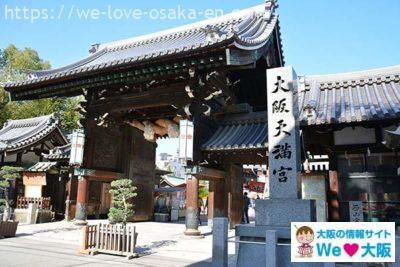
-
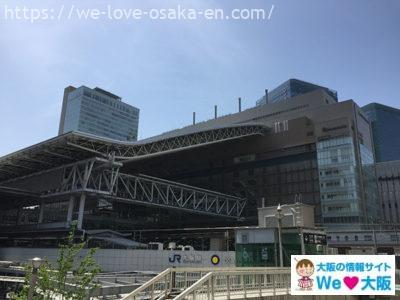
Best Spots in Umeda and Umeda Station, Osaka’s Shopping Center
Osaka has two main downtown ar……2022.09.04







